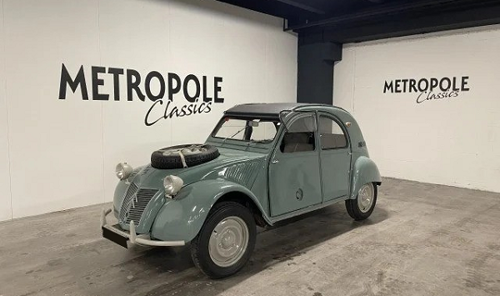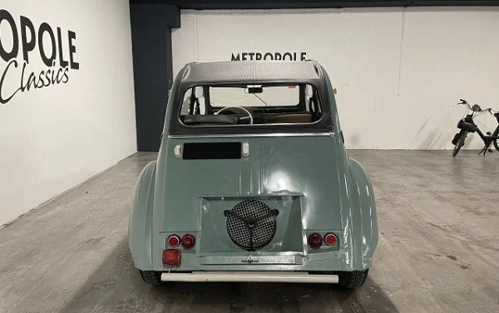Twin Engine 2CV – A 1964 Sahara
06 May 2025
As any motoring enthusiast will tell you that there is no such car as an “ordinary” Citroën 2CV. But this example being sold by https://www.carandclassic.com/car/C1514374 is one of the most remarkable vehicles you are ever likely to meet. Here are 30 facts about the 2CV Sahara – the Citroën with one engine in the front and a second in the rear -

1) In 1955 an aeronautical engineer named Maurice Bonafous created a one-off twin engine 2CV as an alternative to the Jeep.
2) Citroën engineer tested the Bonafous design in 1956 and the company decided to create their own twin engine 2CV for oil companies and colonial officials.
3) Compared with the standard 2CV, the Sahara had a strengthened body, with several unique panels and modified suspension arms.
4) Perhaps the most notable detail was the cutaways in both front doors for fuel filler caps - the front occupants sat atop two 15-litre petrol tanks.

5) The left-hand cap was to fuel the rear engine, and the right-hand cap the front unit.
6) There were also two chokes, two ignitions and two starter buttons – the front on the dashboard and the rear on the transmission tunnel.
7) The Sahara did lack two fuel gauges – instead, the driver had to check petrol levels via a fiberglass dipstick.
8) The rear engine displaced the spare wheel to the bonnet. Citroën considered offering the Sahara without one but were prevented by official regulars.

9) For road use, drivers employed the front 425cc engine and engaged the second motor via a lever mounted to the transmission tunnel’s right for more challenging motoring.
10) Should the front fuel tank empty, the Sahara could run using only its rear engine.
11) The Sahara had a central floor gear lever which simultaneously moved both sets of transmission rods.
12) A hydraulic clutch replaced the standard mechanical set-up.
13) The driver also benefited from a lock indicator on the steering wheel to add progress over challenging surfaces.
14) With both engines engaged, the top speed was 68 mph.
15) According to Citroën, the Sahara could “negotiate gradients of over 40% in sand”.
16) On the 4th of March 1958 Citroën told the press: “A prototype being demonstrated in the Ermenonville Sea of Sand will be presented to the press on March 7, 1958, at 10 am”.
17) Citroën's Head of Publicity stated: "Aware of the problems of oil exploration in the Sahara, Citroën has developed a four-wheel-drive 2CV, adding to the car's long-recognized qualities (lightness, robustness, low maintenance costs, air cooling, etc.), spectacular movement possibilities on the sand”.
18) Autocar of the 14th of March 1958 reported: “So far only one of these ubiquitous vehicles has been made, and the Quai de Javel will assess public and commercial reactions and opinions before proceeding with its production”.

19) The French army evaluated the Sahara in 1959 but did not place an order.
20) Full production began in December 1960.
21) At 10,259 francs, the Sahara cost more than twice the amount of a standard 2CV.
22) In 1962 Citroën renamed the Sahara the ‘2CV 4x4’.
23) Regular production was at the Panhard factory but this 2CV is one of five believed made in Brussels.
24) 86 Saharas destined for the Spanish Guardia Civil were made in Vigo, between July and December 1964.
25) The Spanish government benefitted from a 35% price discount.
26) Nigel Somerset-Leeke, Citroën GB’s Sales & Marketing Manager, had a Sahara at the company’s UK headquarters. Sadly, Citroën GB never assembled RHD Saharas.
27) Regular Sahara production ended in 1966 after 694 units
28) Citroën built an additional Sahara in 1971.
29) Autocar thought: “even with four up, it proved able to overcome the drag of sand which made walking quite a labour, and attacked slopes of about 1 in 3 on the same surface”. Plus, the Sahara offered “increased mobility to oil prospectors, archaeologists, explorers, and the like. It really works - and it’s fun!”.
30) Or to quote Four Wheeler magazine of 1966 - “You Gotta Drive It To Believe It”.
With thanks to Metropole Classics - https://www.carandclassic.com/user/ccts6027 - for their time.
With thanks to Metropole Classics for the permission to use the images in this blog.
